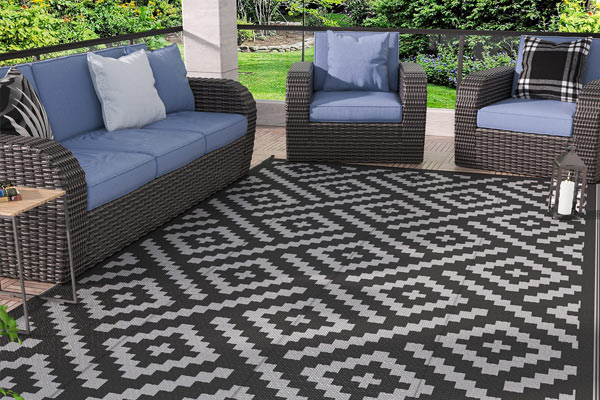Outdoor rugs are versatile and stylish additions to outdoor spaces, designed to enhance comfort and aesthetics in gardens, patios, decks, and porches. These rugs serve as a foundation for outdoor furniture arrangements, providing a cozy feel while defining spaces for relaxation and entertainment. In recent years, they have gained popularity among homeowners looking to extend their living spaces beyond the walls of their homes.

Contents
Definition of Outdoor Rug
An outdoor rug is a type of carpet specifically designed for outdoor use, made from durable materials that withstand various weather conditions. Unlike traditional indoor rugs, outdoor rugs are constructed from synthetic fibers, such as polypropylene, nylon, or polyester, which are resistant to fading, mold, and mildew. They come in a wide range of colors, patterns, and sizes, allowing homeowners to express their personality and style in outdoor areas rug.
History and Origin
Outdoor rugs have their origins in the traditional use of carpets in various cultures to enhance home aesthetics. However, their evolution into practical outdoor accessories began in the late 20th century when manufacturers recognized the need for durable, weather-resistant products. As outdoor living spaces became more popular, especially in urban environments, the demand for stylish yet functional outdoor rugs surged. Innovations in textile technology facilitated the production of rugs that could withstand the elements while maintaining visual appeal.
Types of Outdoor Rug
Outdoor rugs come in several categories, each with unique features catering to different tastes and uses:
Synthetic Fiber Rugs
These are the most common type of outdoor rugs. Made from materials like polypropylene and nylon, they are highly durable, resistant to moisture, and easy to clean. They often mimic the look of natural fibers without the associated maintenance.
Natural Fiber Rugs
Rugs made from materials such as sisal, jute, or seagrass can be used outdoors but have limitations regarding water resistance. While they provide an earthy aesthetic, they should be protected from excessive moisture to maintain their integrity.
Reversible Rugs
Reversible outdoor rugs offer the unique advantage of versatility. With patterns and colors on both sides, they can be flipped for a quick change in decor without needing to purchase additional rugs.
Uses and Benefits
Outdoor rugs offer numerous applications and benefits, making them a staple in outdoor living areas:
- Aesthetic Enhancement: They provide color and texture, enhancing the overall visual appeal of outdoor spaces.
- Comfort: Outdoor rugs give a soft surface for bare feet, transforming hard surfaces such as wood or concrete into more inviting spaces.
- Zoning: They help delineate areas for dining, lounging, or play, promoting organized outdoor spaces that maximize functionality.
- Protection: By placing rugs on patios or decks, you protect the surface underneath from scratches and wear.
- Easy Maintenance: Many outdoor rugs are designed for easy cleaning, allowing homeowners to quickly wipe down or hose off dirt and debris.
How to Choose and Use Outdoor Rug
When selecting an outdoor rug, consider the following factors:
- Material: Opt for synthetic materials for durability and resistance to weather elements. If choosing natural fibers, ensure they are suitable for occasional outdoor use.
- Size: Measure your space to ensure the rug fits comfortably within your layout, allowing enough space for furniture and movement.
- Style: Choose a design that complements your outdoor decor while reflecting your personal style.
- Maintenance: Consider how much upkeep you are willing to commit to when choosing between materials and styles.
Best Practices for Usage: Place outdoor rugs in shaded areas to prolong their lifespan and protect them from fading. Regularly clean and reposition them to prevent mold and mildew buildup.
Maintenance and Cleaning
To ensure your outdoor rug lasts longer, follow these maintenance tips:
- Regular Cleaning: Sweep or vacuum regularly to remove dirt and debris. For deeper cleaning, use a hose to rinse and scrub with mild soap if necessary.
- Drying: Ensure the rug dries thoroughly after rain or cleaning to prevent mold growth.
- Storing: During extreme weather conditions or winter, store the rug in a dry place to protect it from damage.
- Inspect: Regularly check for wear and tear, especially after storms, to address any issues promptly.
Conclusion
In conclusion, outdoor rugs are not just decorative items; they serve essential functions that enhance comfort, protection, and style in outdoor living spaces. Understanding the various types and benefits of outdoor rugs can help homeowners make informed choices that elevate their outdoor experiences. With proper selection, use, and maintenance, outdoor rugs can provide both beauty and durability for many years to come.
